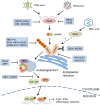cGAS and STING: At the intersection of DNA and RNA virus-sensing networks
- PMID: 30114241
- PMCID: PMC6095619
- DOI: 10.1371/journal.ppat.1007148
cGAS and STING: At the intersection of DNA and RNA virus-sensing networks
Conflict of interest statement
The authors have declared that no competing interests exist.
Figures

References
Publication types
MeSH terms
Substances
Grants and funding
LinkOut - more resources
Full Text Sources
Other Literature Sources
Medical
Research Materials

